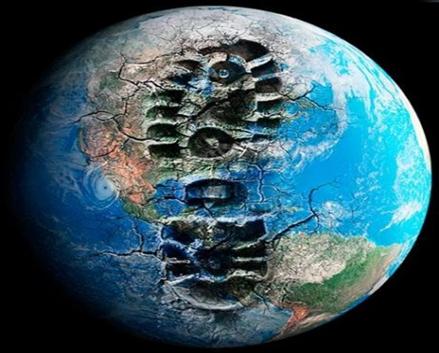TEXT5. THINNING OF THE OZONE LAYER
In photochemical smog at Earth's surface ozone is a harmful pollutant. In the upper atmosphere (stratosphere), however, this gas forms a protective ozone layer about 12 to 30 miles (20 to 50 kilometers) above Earth's surface. This ozone forms when ultraviolet radiation reacts with oxygen gas (02) and it absorbs much of the harmful ultraviolet (UV) radiation that would otherwise strike Earth and harm organisms.

The ultraviolet portion of the electromagnetic spectrum includes wavelengths shorter than 400 nm. UV-B radiation (wavelength 290 to 320 nm) along with radiation of even shorter wavelengths can damage biological molecules such as DNA. In humans the result of exposure to UV-B can be skin cancer or cataracts. UV-B can also harm phytoplankton, the base of the food web in many aquatic ecosystems.
Chlorine, fluorine and bromine – some of which enter the atmosphere as chlorofluorocarbon (CFC) compounds – can accelerate the breakdown of stratospheric ozone. These compounds were once used in refrigerants such as Freon, as propellants in aerosol cans and to produce foamed plastics. They can persist for decades in the upper atmosphere catalyzing chemical reactions that break down ozone. The ozone layer has thinned so much since 1985 that a "hole" has appeared in satellite images over Antarctica. The ozone layer has also thinned over parts of Asia, Europe, North America, Australia and New Zealand. The Montreal Protocol, signed in 1987 and subsequently amended, is an international treaty that calls for the phaseout of most ozone-depleting chemicals early in this century.
Natural events such as the 1991 eruption of Mount Pinatubo thin the ozone layer too. Chemical reactions that deplete ozone occur readily on the dust particles that the volcano sent into the atmosphere. Still, by 1995, when researchers had expected Pinatubo's influence to have waned the ozone hole over Antarctica was still present. The persistence may be due to lingering effects of the volcano increased use of chlorine and bromine-containing chemicals or a cold wave in the stratosphere above Antarctica – or to a combination of these influences. Researchers do not know whether the ozone hole is temporary and localized or the beginning of global ozone depletion.
Correlating ozone depletion to rising UV-B levels has been difficult because many factors can reflect or filter out UV-B including snow, pollution, clouds and volcanic ash. A decade-long study, however, recently strengthened the connection. Researchers monitored midday UV-B levels at a rural part of South Island in New Zealand that is unusually free of these confounding factors. Results were astonishing – UV-B levels are 12 % higher today than they were in 1989! That figure is close to the 15% predicted based on the rate of depletion of ozone in the area since 1978. As a control, the level of UV-A remained constant over the past decade which is consistent with the insensitivity of these longer wavelengths to ozone. To put this information in a human health perspective a decrease in ozone of 1% is associated with a 3% increase in the incidence of skin cancers caused by UV exposure.
Ex.1. Answer the following questions:
- What is a harmful pollutant?
- How does the ozone layer help our planet?
- What can chlorofluorocarbon compounds (CFC) do with the ozone?
- Where were chlorofluorocarbon compounds (CFC) used?
- Why are chlorofluorocarbon compounds (CFC) dangerous for ozone?
- Where on the Earth has the ozone layer thinned?
- What is the Montreal Protocol?
- What natural events can thin the ozone layer? How?
- Is the ozone hole over Antarctica temporary and localized or the beginning of global ozone depletion?
- What factors can reflect or filter out UV-B levels?
- What were the results of the researchers’ monitoring midday UV-B levels?
- Why is it dangerous for our health to stay in the sun for a long time?
Ex.2. Give Russian equivalents for the following:
Harmful pollutant; wavelengths; to damage; skin cancer; the breakdown of stratospheric ozone; aerosol cans; to produce foamed plastics; international treaty; ozone-depleting chemicals; eruption of Mount Pinatubo; the ozone hole; combination of influences; localized; global ozone depletion; can reflect or filter out UV-B; volcanic ash; remained constant over the past decade; UV exposure.